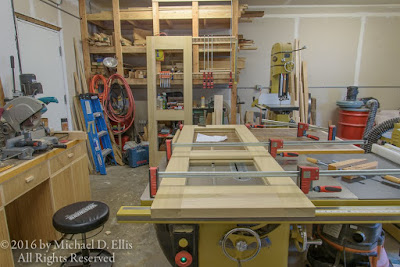The tools we use to form wood, whether power tools or hand tools, all require maintenance.
 |
| A selection of edge tools |
While all maintenance is necessary, I have found that keeping the cutting edge of my tools sharp is one of the most important parameters to keep an eye on. Every time I change a blade or bit I check it visually for cleanliness and sharpness. Every time I pick up a chisel or plane I check the set up and sharpness. I try to keep my hand tools ready for use by sharpening them after a project has been completed but these often need to be touched up in use.
Most power tool blades, bits and knives have carbide cutters and some pretty critical dimensions to maintain so I send out my table saw blades for sharpening. I usually replace dull router bits since I have not had good luck having them sharpened. Band saw blades are also replaced when dull. I do sharpen some of my drill bits. I have segmented cutters on the planer and jointer so they don’t get sharpened, just turned and eventually replaced.
 |
| Segmented cutterhead on a Powermatic jointer |
Hand tools need frequent sharpening when used. I have tried a few methods and have researched a lot of machines, jigs and stones for sharpening before settling on the method I currently use. My criteria were: first, producing a fine edge, second, ease of set up and use and third, expense.
I have used sharpening stones extensively and they work well but I have found some drawbacks. Good quality large stones are kind of expensive. A set of 4, coarse lapping, coarse, medium and fine, can easily set you back 2 to 4 hundred dollars. They can be fragile and they do wear. Waterstones need special containers and regular flattening.
There are machines (Tormek etc.) which can work very well and the sharpening is automated to some extent. A large variety of machines are available which vary in quality, ease of use, results and cost. I have little experience using them but I do know people who have a system similar to this and they use it infrequently because it is quicker to just pull out a stone and touch up that chisel or plane blade than set the machine up. If you are sharpening all your tools at once I think these systems can be a real time saver. If you have the space to keep it set up ready for use it may be easier to use. These systems range in cost from 1-200 on up.
After using stones for a long time I read about a product in the Lee Valley woodworking catalog called lapping film.
 |
| 3M lapping film |
Made by 3M, this film is produced for the Telecomm industry to polish fiber optic cable connections and is available with a pressure sensitive adhesive backing. It comes in 15, 5 and .5 micron sizes. This film is made to high specifications regarding the size of the abrasive particles so you won’t get odd scratches as you work your way through the grits as can happen if you use sandpaper. I decided to give it a try for sharpening and it has become the sharpening medium I use.
You need a flat substrate to adhere the film to so I purchased a piece of float glass as a substrate. I bought this from Lee Valley, but it is also available from Rockler. I cut the film to fit my largest plane blade, about 3 inches wide. I carefully apply the sheet to the CLEANED piece of glass. Be careful of trapping air bubbles under the film. If you get some, slit the film with a knife at the bubble and roll it down. I then use a roller to seat the film and remove any trapped air bubbles. Add a few drops of oil and you are ready to go.
 |
| Lapping film attached to glass plate |
I sharpened without a guide for years but as I became a better woodworker I wanted better results. I thought that a guide would help me acheive a better result. There are several devices available to hold your blades and chisels at the correct angle for sharpening.
 |
| Several holders for sharpening. Veritas holder on left. |
I currently use the system made by Veritas, the Veritas® Mk.II Honing Guide System available from Lee Valley Tools. It consists of the holder/guide and an attachment to set the projection of the blade. It holds most of my chisels and all of my plane blades. This device allows me to easily set the chisel or blade to the same angle each time. This really helps with keeping your tools sharp.
Next time I will go over the methods I use to sharpen my chisels and planes.


















































